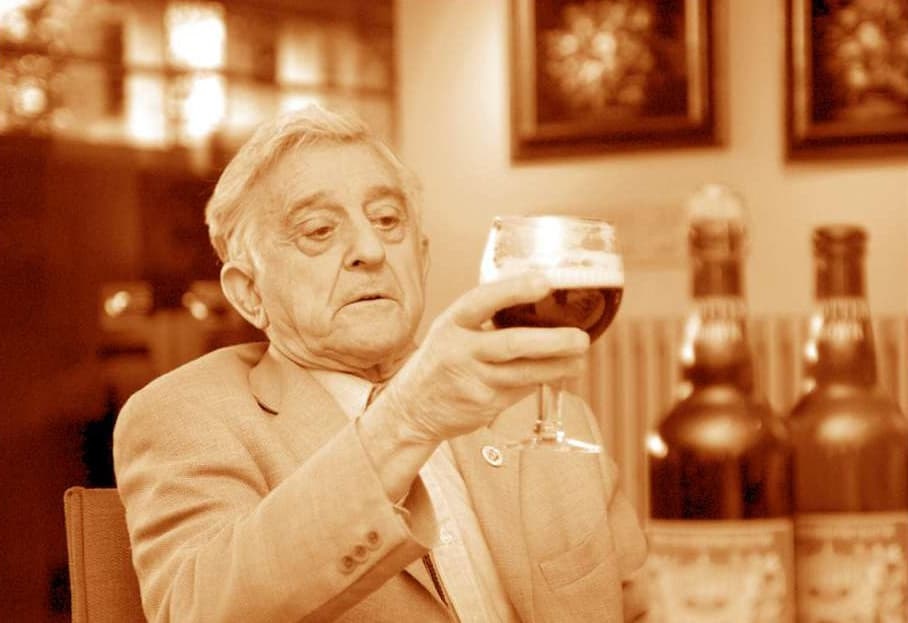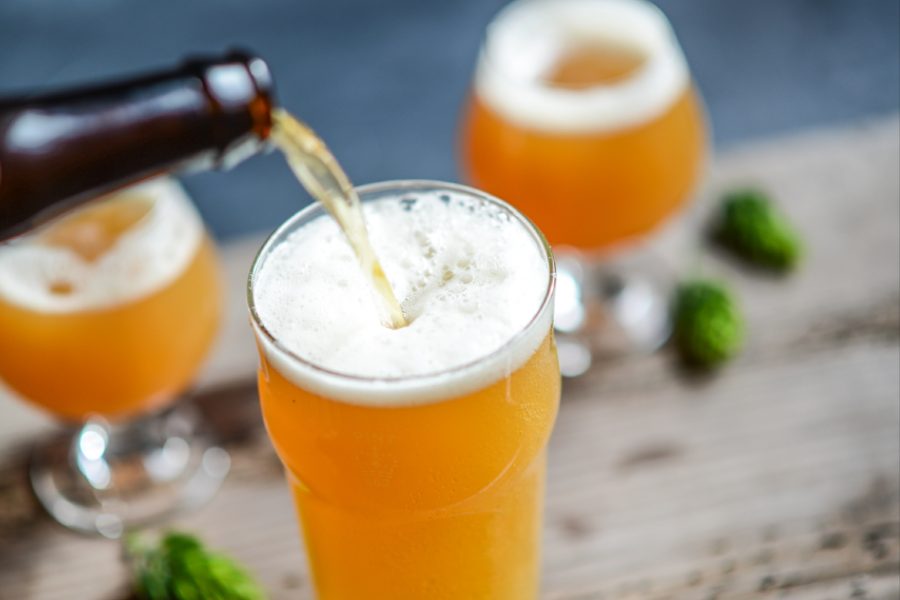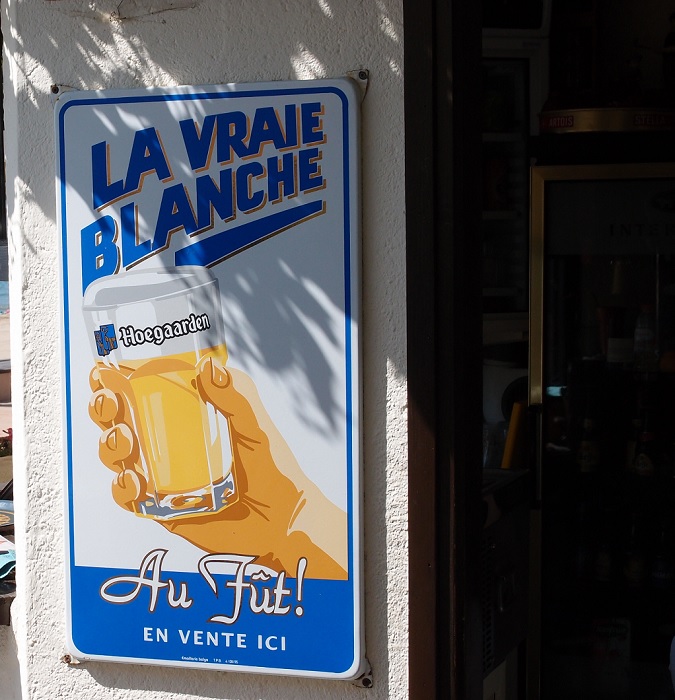Belgian witbiers are pale, hazy beers, brewed using between 30 to 60 percent of raw wheat relative to the usual barley malt in their grain bill. This high proportion of wheat gives wibiers a zesty, refreshing quality and a smooth, creamy mouthfeel, as well as delivering the beer’s signature cloudy appearance.
The Dutch word ‘wit’ does not mean ‘wheat’, but rather translates as ‘white’, a nod to their haziness and pale colour (in French, they are known as ‘blanche’). The wheat’s proteins, polyphenols, and starch are major haze components that stay suspended in the beer.
Witbiers are fermented with a particular family of Belgian ale yeast strains that produce spicy phenol compounds. These show up as notes of white pepper, and fruity ester compounds that present like lemon and orange aromas and flavours. The high proportion of wheat and low colour barley combine to produce a bready maltiness, often with light notes of honey and vanilla.
The final piece of the puzzle is the kettle addition. Witbiers are commonly spiced, most often with coriander and bitter orange peel, but sometimes with elderflower. These additional flavours complement the yeast strain and balance the sweetness and light acidity of the grains.
The most famous Belgian witbier is Hoegaarden, but there are a whole host of wheat beers in Belgium which offer a range of different flavour experiences.
Given their lower alcohol content and thirst-quenching nature, witbiers are most associated with summer drinking. But if you’re seeking an accessible, easy-drinking beer to keep your autumn interesting, they might be your great white hope.
At your wits end
Wheat does not just make an appearance in Belgian brewing. It plays a starring role in many international styles.
The Germans rely on it for their Weissbier or Weizenbier, with the Bavarian Hefeweizen using malted wheat for up to 70 percent of its grain bill. This produces a creamy, refreshing base for an ale yeast which delivers a clove-like spiciness and a banana fruitiness.
The Berliner Weisse, on the other hand, is a low alcohol lactic-fermented ale often produced using 30 percent wheat, its acidity sometimes cut by the addition of raspberry or herbal syrups.
Gose beer, from Goslar in Lower Saxony, is brewed with wheat malt as well as barley malt and oats. It is spiced with coriander, flavoured with salty brewing water, and subjected to a lactic fermentation.
In the United States too, brewers have played with wheat. American wheat ales are effectively unfiltered blonde ales brewed with a high proportion of wheat which show off a pronounced American hop character.
Wheat has made its way into more modern styles as well. The amounts of wheat used in hazy IPAs in recent years mean they are sometimes more like a highly dry-hopped wheat ale than a classic pale ale.
While brewers in other countries use malted wheat in their wheat beers, the Belgians use raw wheat.
One reason for this is that unmalted grains were for a long period in the first half of the 19th century taxed at half the rate of malted grains. Brewers in Flemish Brabant, where wheat agriculture was abundant, used more and more wheat in their beers to minimise their tax liabilities. Wheat was good for business.
Belgians also used raw wheat for its more robust flavours, distinctive mouthfeel, and positive head retention properties. Wheat contains high levels of gummy carbohydrates such as glucans and pentosans which increase viscosity in a beer.
While wheat can be difficult for brewers to deal with in the brewhouse, causing slow runoffs and inefficient mashing, Belgian brewers are fond of the results: a smooth body, great foam stability, and an ice-creamy, mousse-like head.
Sorting the wit from the chaff
The area around Leuven in the province of Flemish Brabant – in particular, the town of Hoegaarden – is synonymous with Belgian witbier. The wheat grown in the region around Leuven gave rise to many different types.
The Leuvensch Wit was often consumed very young, its herbal profile resulting from mashing with rootlets intact. The Peeterman tended to be boiled longer, giving a darker colour with honey-like notes.
The Hoegaardse, made with both wheat and wind-dried barley malt, was spontaneously fermented in a wooden coolship with natural acidification by wild lactic acid bacteria.
Hoegaarden remains the most famous witbier today. It was created in 1966 by a Belgian milkman called Perre Celis, who started brewing it in a vacuum. Like many of Belgium’s regional specialities, witbier production declined in the first half of the 20th century as lager brewing rose. At its peak in 1758, the town of Hoegaarden supported 38 breweries producing witbier, the last of which, the Tomsin Brewery, closed in 1957.

Hoegaarden creator Perre Celis
Facing a vanishing beer style, Celis brewed his Hoegaarden witbier in his own brewery, Brouwerij De Kluis. He spiced the beer with a classic mix of bitter orange and coriander, but he is also reported to have thrown in chamomile for extra delicate fruitiness. His beer soon caught on, not just locally, but across Belgium.
After a fire in the brewery in 1985, Celis sought financial help and Leuven-based brewery Interbrew offered him a loan. However, Celis reportedly felt the loan came with demands to tweak the beer’s recipe. In 1989, he sold the brewery to Interbrew, which used its distribution network to crank up the reach of Hoegaarden to bars around the country and beyond. Interbrew is now AB InBev, the world’s largest brewer, and Hoegaarden still has a prominent place in their line-up today. It is also, by far the most well-known and accessible Belgian witbier in the world – even if its formula has changed.
Five Belgian witbiers to try
Hoegaarden’s commercial success prompted almost every brewery in Belgium to brew their own witbier, and as a result, there’s a whole host of great Belgian Witbiers to try. Here are five to get you started:
- Sint Bernardus Wit (5.5 percent ABV, Brouwerij Sint Bernardus): A modern classic from Watou on which Pierre Celis himself is said to have consulted.
- Jan de Lichte (7.5 percent ABV, Brouwerij De Glazen Toren): A stronger ‘Dubbel Wit’, named after a famous thief and murderer local to this brewery in Erpe-Mere.
- Forêt Blanche (5.5 percent ABV, Brasserie Dupont): A traditional wheat beer with the trademark dryness and citrus character of the Dupont house style.
- Space Cadet (5 percent ABV, Brouwerij ‘t Verzet): A fruity, thirst-quenching beer from a maturing young brewery which uses hops and a special yeast to replace the coriander and curaçao notes.
- VI Wheat (6 percent ABV, Brasserie de Jandrain Jandrenouille): A version showcasing more tropical fruit-like American hops whose beer name demonstrates the Walloon brewer’s love of Star Wars.


